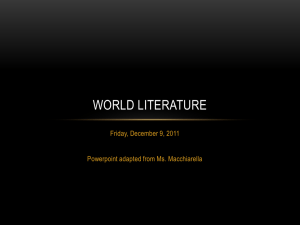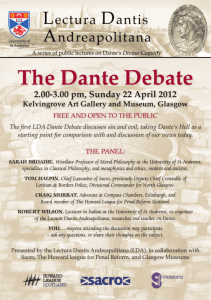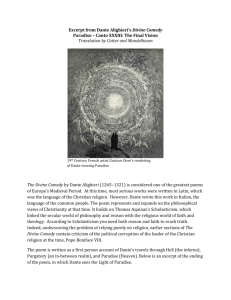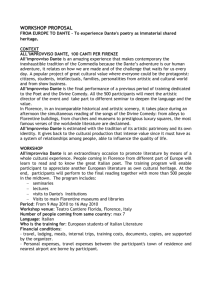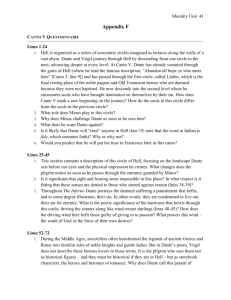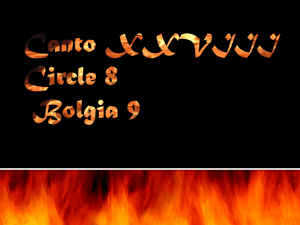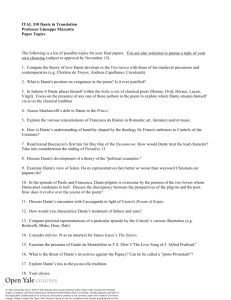Access article in PDF - The Canadian Catholic Historical Association
advertisement
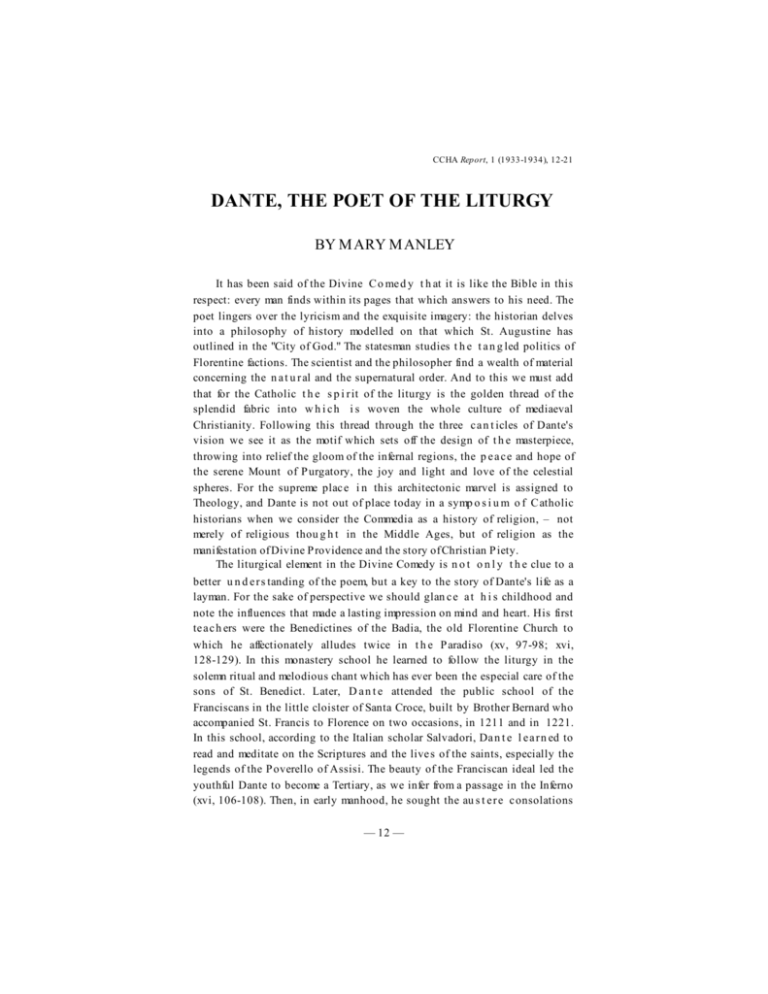
CCHA Report, 1 (1933-1934), 12-21 DANTE, THE POET OF THE LITURGY BY M ARY M ANLEY It has been said of the Divine C o me d y t h at it is like the Bible in this respect: every man finds within its pages that which answers to his need. The poet lingers over the lyricism and the exquisite imagery: the historian delves into a philosophy of history modelled on that which St. Augustine has outlined in the "City of God." The statesman studies t h e t a n g led politics of Florentine factions. The scientist and the philosopher find a wealth of material concerning the n a t u r al and the supernatural order. And to this we must add that for the Catholic t h e s p i r it of the liturgy is the golden thread of the splendid fabric into w h i c h i s woven the whole culture of mediaeval Christianity. Following this thread through the three c a n t icles of Dante's vision we see it as the motif which sets off the design of t h e masterpiece, throwing into relief the gloom of the infernal regions, the p e a c e and hope of the serene Mount of P urgatory, the joy and light and love of the celestial spheres. For the supreme plac e i n this architectonic marvel is assigned to Theology, and Dante is not out of place today in a symp o s i u m o f C atholic historians when we consider the Commedia as a history of religion, – not merely of religious thou g h t in the Middle Ages, but of religion as the manifestation of Divine P rovidence and the story of Christian P iety. The liturgical element in the Divine Comedy is n o t o n l y t h e clue to a better u n d e r s tanding of the poem, but a key to the story of Dante's life as a layman. For the sake of perspective we should glan c e a t h i s childhood and note the influences that made a lasting impression on mind and heart. His first te a c h ers were the Benedictines of the Badia, the old Florentine Church to which he affectionately alludes twice in t h e P aradiso (xv, 97-98; xvi, 128-129). In this monastery school he learned to follow the liturgy in the solemn ritual and melodious chant which has ever been the especial care of the sons of St. Benedict. Later, D a n t e attended the public school of the Franciscans in the little cloister of Santa Croce, built by Brother Bernard who accompanied St. Francis to Florence on two occasions, in 1211 and in 1221. In this school, according to the Italian scholar Salvadori, Da n t e l e a r n ed to read and meditate on the Scriptures and the live s of the saints, especially the legends of the P overello of Assisi. The beauty of the Franciscan ideal led the youthful Dante to become a Tertiary, as we infer from a passage in the Inferno (xvi, 106-108). Then, in early manhood, he sought the au s t e r e c onsolations — 12 — of philosophy "in the schools of religious", as he tells us in the Convito. With the Dominicans of Sant a M a r i a Novella he studied philosophy and theology, a pupi l o f t he famous Fra Remigio Girolami, who was at that time expounding the works of St. Albert the Great and St. Thomas in the renowned monastery of Florence. In these early associations with Benedictine, Franciscan, and Dominican teachers we see the sowing of the seed which was to bear fruit in the liturgical overtones, the mystic idealism, and the structural perfection of the Divine Comedy. A second phase of his life which we must briefly consider is the visit to Rome at Eastertide of 1300. This centennial year was momentous in the history of t he Church and in the life of the poet. It marked the first Universal Jubi l ee or Holy Year, instituted by P ope Boniface VIII in a Bull dated February 21st, 1300. This fact is of historical significance t o day when the Catholic world enjoys the spiritual benefits of the twenty-fourth Hol y Y ear, recently prolonged by Our Holy Father to commemorate the nin e t e e n t h centenary of the Crucifixion. At a moment when his heart was heavy with personal grief and politi cal reverses Dante made the pilgrimage to Rome, as we infer from passages in the P oem. These allusions have the savour of devout recollec t i o n , and, for us, a certain historical interest in the reference s t o the vast concourse of pilgrims, to th e i mp ression made on the visitors by the sight of the great and ancient monuments of Rome, and to the piety of t h e faithful as they venerated the holy relics. The assignment o f h i s Mystic Voyage to the ideal date of Eastertide in the year 1300 points to the crystallization of his purpose to write the Sacred P oem on which he had been meditating fo r t e n y e a rs, and it implies his conversion from an a c tive worldly life to the consideration of things "sub specie aeternitatis". In a letter to his benefactor, Can Grande della Sca l a , t o whom he dedicated t h e D i v ine Comedy, Dante explains the meaning of his P oem and the fourfold sense in which it is to be interpreted. He tells us that "the subject of t h e w h o le work, taken according to the letter alone, is simply a consideration of the state of souls after deat h ... But if the work is considered according to the allegorical meaning, the subject is man, liable to the rew a rd or punishment of Justice, a c c o r d i ng as through the freedom of the will he is deserving or undeserving." He declares that the aim of the P oem "is to remove those living in t h is life from a state of misery and to guide them to a state of happiness". It is to this end, because the Divine Comedy was undertaken "not for the sake of speculative philosophy but for the sake of practical needs" that Dante made Church doctrine and p r a ctice the woof of his fabric. He used the sacred — 13 — words of Scripture and the inspired teaching of the Church, her sacraments and sacramentals, her Divine Office, melodies and sacred art, her orderly ritual and pious pr a c tices, blending all that dogma and tradition had taught him into a living whole that has the austere and subduing b e a u t y o f a liturgical ceremony. We shall now consider the Div i n e C o medy as a mosaic of Christian doctrine and discipline, and follow the ritual and worship of t h e C h urch as Dante traces it in the steps of a pilgrimage that led him, as he devoutly hoped it would lead others, from the slavery of sin to the liberty of the City of God. The epoch of the P oem is Eastertide of the year 1300 and the chronology follows the drama of the P aschal cycl e a s i t c omes to a climax in the Death and Resurrection of Our Lord. The night of Holy Thursday, anniversary of the vigil which t h e S a v i our made in the Garden of Gethsemane in sadness and grief of he a r t o v e r t h e sins of the world, Dante has spent in a Dark Wood overwhelmed with b itterness and remorse for the sins which had brought his soul near to the point of death. The dawn of Good Friday brings a ray of hope as the Sun, which "leads men st r a i g h t on every road", shines from a hilltop, foreshadowing the light brought to the world by the Victory of the Cross on C a lvary. His efforts to climb the hill are frustrated by three beasts who threaten to d e s t r o y him, and all but thrust him back to the depths of the valle y fr om which he had just escaped. The voice of reason, in the person of Virgil, counsels him to s e e k "a nother way" of ascending the hill. Under the guidance of Reason he must first go through a n e t e r n a l place and hear "the hopeless shrieks of the spirits in pain", then into the region of those who are contented in the fire, for they hope to come amo ng the blessed. At this point he will have reached the summit of the Sunlit Hill which he could not ascend solely by his own effort. If he wishes to mount still higher, ano t h e r guide, a worthier spirit, will le a d h i m t o the court of the Emperor, into whose City Reason alone may not take the soul, which has need, o f D i v i ne Revelation, i n t h o s e lofty matters that are beyond the score of human understanding. Dante begs Virgil to lead him to the Gate of St. P eter, and prepares to follow the Mystic Guide into the realm of darkness, where he remains from sundown of Good Friday until dawn of Easter Sunday, for his sojourn in the "place void o f all light" synchronizes with the interlude of darkness and desolation w h i c h t h e Church prescribes in commemoration of the time Our Lord spent in the tomb. The first canto of the Inferno, the prelude to the whole poem, is filled with the accents of w o e that sound in the Lenten liturgy, especially that portion of the Scriptures assigned to the latter part of Holy Week. Th e r e are echoes of the Vesper Antiphons of H o ly Thursday, of the P enitential P salms and of the prophecies read in the Mass of the P re-Sanctified. The opening line — 14 — of the Divine Comedy is a literal transcription of a ver s e i n the prophecy of Hab a c u c which forms the Tract of the Mass. The prophet cries: "O Lord, thy work, in the midst of the years bring it to life. In the midst of the ye ars Thou shall make it known: when Thou art a n g ry Thou wilt remember mercy" (Hab. 3). The P oem opens with the verse : "I n the middle of the journey of our life I came to myself." In the literal sense this refers to his thirty-fifth year, for the days of our life according to the P salmist , are "three-score years and ten" (P s. 8 9 , 1 0 ) , and Dante was born in 1265. In the moral sense, the allusion is t o the per i o d when calamities overwhelmed him, for that year marked a crisis in his private an d h i s p o l itical life. In the Convito, Dante compares man's life to an arch the peak of which is reached in the thirty-fifth year, therefore Christ died in His thirty-fourth year, since i t w a s n ot fitting that Divinity should s u ffer a decline (Conv. IV, 24). Dante, well-versed in the Scriptur e s , a n d familiar with this prophecy as part of the Mass, knew that by "thy wo r k " the prophet meant the g r e at work of the redemption of man, which the Lord will b r i n g to life and light in the midst of the years, that is, when calamities and miseries shall be at their height. As he descends from circle to circle of the infernal abyss Dante views the havoc wrought by sin in the soul of man, and hears the wailing and gnashing of teeth of those upon whom their sin recoils as punishment. Th i s illustrates the principle of contrapasso, the structural idea of the Inferno, according to the P salmist: "His sorrow shall be turned u p o n his own head: and his iniquity shall come down upon his crown" (P s. VII, 1 7 ) . The name of Christ is never pronounced in the Inferno, the Saviour being there refer red to by means of periphrasis, such as "the Highest Wisdom" (III, 6), or "the Man Who lived a n d d i ed without sin" (XXXIV, 15). The Biblical warrant for this concept i s found in th e fi r st penitential psalm: "For there is no one in death that is mindful of thee; a n d w h o s h all confess to thee in hell? " (P s. VI, 6). Nor is there any reference to the events of Our Lor d ' s life save His descent into Limbo (Inf. IV, 52-61), and the allusions t o those who suffer punishment for thei r i n fa mo u s share in His death. That Hell was branded with the mark of ruin in the earth q u a k e at the moment of the Crucifixion we learn from the demon Malacoda, in charge of t h e c i r c l e where Barterers are punished, who points to the pathway cleft through the abyss and tells the pilgrims: "Yesterday, five hours later than this hour completed a thousand two hundred and sixty-six years since the way here was broken" (Inf. XXI, 112-113). Dante reaches the lowest P i t of Hell during the night of Holy Saturday, the time which the early Church spent in vigil, the ceremonies of the blessing of the fire , t h e blessing of the fonts and the water for baptism being then performed after sundown of Saturday. A t t h is moment when the Church prepares to celebrate the t riumph of Christ as the Son of God, Dante beholds — 15 — Satan as the incarnation of blasphemous majesty. The Arch-traitor bears on a s i n g l e t orso the heads of three traitors, Judas, Brutus and Cassius. The concept underlying t his grotesque imagery can be traced to St. Augustine, who states in his work o n t h e Tr i n i t y that the greatest sin is homicide, of which Judas, Brutus and Cassius were guilty, b e c a u s e i t is opposed to the greatest love which is to give life (De Trin. IV, P .L . 42, col. 9)0). Dante illustrates this concept by a terrifying travesty i n t h e fr o zen marsh of Hell. L u c i fer's triumph over the souls of unrepentant sinners is accompanied by a grim parody o f the "Vexilla Regis", the hymn of Fortunatus which is sung on Good Friday as the B l essed Sacrament is taken from the Repository. It is the liturgical hymn for Vespers of P assion Wee k i n which the Church, secure in victory over the enemies of salvation, celebrates the. Triumph of the Cross. From this view of the P rime of Darkness, "the creature which was once so fair", Dante is carried through the centre cf the P it by his Mys t i c Guide and led into the bright world. The glorious dawn of Easter finds him at the base of the Sun l i t M o u n t which he could not ascend until he had realized the nature and the appalling consequences of sin and had understood the meaning of Divine Justice. He is now ready for the remedial discipline which the Church teaches is necessary in this life or in the next, whereby the traces of sin are washed from the soul by prayer and pen a n c e , and it regains the innocence of our first parents before the Fall. In the literal sense, the second, realm is a vision of the state of souls wh o d i e d i n faith and repentance, but who must render satisfaction to Divine Justice for the full penalty due to sin. And Dante states explicitly the penal nature of P urgatory: "I would not , r e a d e r , that thou be scared from a g o od purpose through hearing how God wills that the debt be paid. Heed not the form of the pain; think what followed, that at worst beyond the great judgment it ca n n o t go". (X, 106-111). And again we learn from the life story of one of the souls expiating pri d e , "such coin he paid back in satisfaction who yonder is too daring" (XI, 125). The longing of the souls for prayers from those on e a rth is one of the most touching features of the P urgatorio. One of the Late-Repentant, still outside the Gate of P urgatory, te l ls the poet that he is due for a long delay of penance, "unless before, a p r ayer aids me, which may rise up from a heart that lives in grace" (IV, 13 3 ) . Another asks that Dante Will remind his fellow-citizens to be gracious of their prayers "that I may purge away my heavy offences" (V, 70). Of all these souls, whose delay in beginning the penance they long to perform is in propor t ion t o t h e d elay of repentance while on earth, the poet says, "whose one desir e was that others pray, we that their way to blessedness be sped" (VI, 25). In the allegorical sense the P urgatories is the story of the real life of a man on earth, painfully treading the pat h o f c o n trition and self-reformation in — 16 — preparation for the life of eternal blessedn e s s . In the P oet's words, it is "that second realm where the human spirit purifies itself and becomes worthy to rise to h e a v e n " (I, 4-6). In the arrangement of the P urgatorio in this sense Dante has combined the prayers and hymns, the prac t i c e s a n d devotions of the Church into an orderly ritual des i g n e d to aid the soul in the acquisition of virtue. The moral basis of the P urgatorio rests upon St Augustine's definition of virtue as "the right-ordering of love". At the moment when the Church lights the P aschal candle to signify the glory o f t h e R i s en Christ, "the Light of the Work", the P oet issues forth to behold again the st a r s . I n this radiance of Easter dawn we have a felicitous association with the words of the Mas s o n Easter Sunday. The Introit is the psalm of thanksgiving for God's special providence over His servants; the Gradual and Vesper Antiphons express praise and gratitude for d elivery from sin: "Th i s i s t he day which the Lord hath made; let us be glad and rejoice t h e r e i n " (P s. 117, 74). In the prayer of the Mass the words of the priest are that "God may open the door of eternity". In the Epistle, St. P aul admonishes, "purify yourselves from the old leaven". (1 Cor. 5). Dante takes the first step in the cleansing of his soul when Vi rgil girds him with a rush , a s y mb ol of humility, and bathes his face with dew, to signify a prayer for purity of heart. The rush is the mystical counterpart of hysso p , a nd we must note here the association of Dante's preliminary rite of purification with certain features of the P aschal solemnity under the Old Law, where the Israelites dipped a lunch of hyssop in the blood of the paschal lamb and girded the loins in celebrating the P assover (Ex. XII, 11, 2 2 ) . D ante commemorates the rite in its spir i t u a l sense, that is, an expression of instant w i llingness to do the will of God. He heard in the Tract of Good Friday th e prophet's words, "That I may go up g i r d ed to our people that are girded" (Hab. 3, 16), which signified in the Jewish rite the preparation for the journey to join the happy company in the boson of Abraham. A n d the celebration of the new P asch requires the same purification and p r e p aration by the pilgrim who is about to begin the journey to the Heavenly Jerusalem. In the Ante-purgatory, where he spe n d s Easter day, Dante sees the first of the glorious band of angels who guard the holy mount and guide the souls a t every turn. For in the words of the P salmist, quoted by S a t a n i n t h e Temptation (Matt. IV, 6) : "He hath given his angels c h a r g e over thee, to keep thee in all thy ways" (P s. XC, 11). The Celestial P ilot who guides an oarless, sailless barque of happy souls from the shore of t i me to that of eternity, is as dazzling in his radiant whiteness as the angelic witnesses of the Resurrection, described in the Gospel of the Mass of Easter. The Guardian Angels of the Mount, c lad in green, fanned an d s mitten by green wings, bear two blunted swords with — 17 — which they put to flight the serpent that thrusts its he a d i n t o the Valley of P rinces at sunset. The P riest-Angel at the Gate of P urgatory is the c onfessor in ash-coloured garme n t who holds the keys of judgement and authority, by virtue of which he will abso l v e t h e penitent Dante, and he engraves on his brow seven P 's, each signifying a peccatum to be clea n s e d i n successive terraces. The seven ministering angels are each in charge of a terrace to encourage the souls by the gentle repetition of a beatitude. Of these seven angels in their successive apparitions, the German Dantist Witte has sa i d : "They are among the divinest things of beauty in the Divine Comedy". As P urgatory, whether in this life or in t h e next, is not only a period of prayer and penance, but also an educati v e d iscipline in virtue, the souls are encouraged to set love in order by meditating on episodes i n t h e life of the Blessed Virgin. The exquisite beauty of the sculptured scenes on the w a l l of each terrace makes the second canticle a commentary on sacred art as Dane knew it from the Catacombs, the Churches and the works of his contemporaries. In representing Our Lad y a s t h e t ype of virtues opposed to the Seven Deadly Sins, Dante must have been inspired by the Gospel of St. John In the Mass of Monday of Holy Week. It is i f t h e story of the generosity Mary Magdalene in p o uring the precious ointment on the Master's feet, contrasted with the avarice of Judas who begrudged the waste, "not because he loved the poor but because he was a thief, and c a r r y i ng the purse he had all that was therein" (John XII, 1-9). The name o f M a r y, like the Name of Jesus, is never heard in the Inferno. She is alluded to there as the "donna gentile", type of the Divine Mercy, who obtains the initial grace for a soul in peril. In the realm of penance, where the soul has need of her example and influen c e , Dante dramatizes with all the e mb ellishments of art and song the rôle which the Church assigns to t h e Mother of God. To the once-proud souls a marble sculpture of the scene of the Annunciation p r e s e n t s Mary is the Model of Humility in her answer to the Angel's message, "Ecce ancilla Dei." In the terrace of the Envious s h e i s an example of Love as voices of unseen spirits chant "Vinum non habe n t ", recalling her loving car e o f the unprovided guests at the marriage feast of Cana. In the terrace of the Wrathful, Our Lady is a mo d el of Meekness, as Dante sees in a vision "ma n y persons in a temple, and a woman about to enter, with the tender attitude of a mother, saying: `M y , Son, why hast thou thus dealt with us? "' In the terrace of the Slothful, Mary is an example of Zeal t o souls who now run to and fro, incited to activity by the contemplation of her haste into the hill country to visit her cousin Elizabeth. To the Avaricious and P rodigal she is the type of P overty, the Mother whos e s on was born in — 18 — a manger. To the Gluttonous souls a hidden voice recalls the Temp e r a n c e of Mary whose action at the marriage feast was for the wants of others, not for her own gratification. She is an example of Chastity to the once-lustful souls who pass through the purifying fl a me s r e c iting her words to the Angel Gabriel, "Virum non cognosco." In this sevenfold representation of her lofty virtues on earth Dante gives us a study in miniature of Our lady's life. The beautiful hymns and canticles of the Divine Office fill the P urgatorio with accents of calm and holy hope. The souls in the barque of the Cel e s t ial P ilot r e a ch the Mount singing "In exitu Israel de Aegypto," the P salm of the Exodus, which signifies their liberation from the bond a g e of sin. The late-Repentant and Violently-Slain cross the mountai n s l o pe chanting the Miserere, verse by verse alternately, a psalm which the Church includes at the Ve s p e rs of Holy Thursday. in the Valley of P rinces, at the pensive h o u r o f sunset, Dante is rapt out of his very self by the voice of a spirit intoning 'Te Deum laudamus." The Church prescribe s t h i s hymn for Matins whenever the Gloria is sa i d a t mass, and for special occasions of praise and thanksgiving. D a nte hears it as when the people are singing with an organ a n d n o w t h e words are clear and now are not" (P urg. IX, 139), and by this sugge s t i ve allusion he recalls the solemn occasions when it occurs in the liturgy. On the evening of the third day Dante hears the beautifu l Ambrosian hymn, "Sumnae Deus Clementlae," sung by the souls pass i n g t hrough the heart of t h e g r e a t b u r ning in atonement for the sin of lust. It is the Matins hymn of Saturday and is wholly appro p r i a t e to the occupants of this terrace w h ose prayer and penance are epitomized in the third stanza. Dante, wi t h Virgil and Status, passes through the purifying flames, the fi n a l expiatory duty of P urgato r y , a n d is welcomed by an angel with the words of Christ's promise: "Come, ye blessed of my Father," words fro m the Gospel of St. Matthew in the mass of that day. Dante recognized the fact that an allusion gains half its po w e r fr o m its connection with the reader's memory and previous e xp erience. In order to be forcible and effective it must be at least so familiar as to awaken a train of associat i o n s i f the author touches the first note of well-known airs, then memory will supply the accompaniment to enrich his music . Th i s is what Dante, with the i n s t i n c t of true genius, has achieved. The Catholic heart is awakened and profoundly moved by the paraphrase of the Lord’ s P rayer on the lips of souls expiating the sin of pride; it is consoled as angelic voices repeat the Beatitudes; it responds with instant sympathy to the note o f j o y in the Gloria that goes up on all sides as a soul, cleansed from the sin of avarice, is released from P urgatory, and it responds again to the pathetic utterance of the once wrathful sons who can only re p eat over and over, "Agnus Dei," as they strive to acquire the meekness of the Blessed L a mb . O r again, the hallowed — 19 — association with the common of the Mass adds to the solemn grande u r of the Mys t i c P a geant in the Earthly P aradise, as the holy elders chant "Hosanna, Benedletus qui venis", and a t r i u mphant Alleluia sounds from a hundred. voices, the "ministers and messengers of life eternal " And the intoning of the mystically beautiful "Veni Sponsa" in thi s r e g ion of innocence recalls the ceremony of religious profession. At sunrise of Thursday of Easter Week, accordin g t o t h e Dantean schedule, the pilgrim enters the Earthly P aradise, where he views the sublime P ageant of the Ch u r c h i n multiform symbolism, reminiscent of the vision of Ezechiel and of the Revelation of S t . John, as commentators point out. As Dante's heaven is still before us we can not linger with him in the delights of Eden. We would need the six hours he spent there to treat e v e n w i t h scant justice the wealth of apocalyptic imagery and the harmony of triumphant song t h a t accompanies the Mystic P rocession which is, we feel, the sensible sig n of the suprasensible mystery of the divine guidance of the Church. The sweet strain s of song that kindle the air are psalms of praise and thanksgiving. The P roper of the Mass for Thursday of Easter Week provides an il l u minating commentary on the spiritual meaning of this subli me scene. Turning from the last five cantos of the P urgatorio to the Missal we realize that the Dantesque Eden is a dramatic and lyric version of the joyous Easter liturgy. The Guardian Spirit of the Earthly P aradise is t h e s e r e ne and gracious Matilda, a figure, I thi n k , o f t h e maternal spirit of the Church. She leads Dante through the stream of Lethe which removes the memory of evil, and the "Asperges" sounds so sweetly that he cannot remember, much less describe it; then through the stream of Emoè, which fills his soul wit h b e n e v olence. This signifies to water of life according to the words of Our Lord in the fourth chapter of St. John ' s G o s p e l : "Unless a man be born again of water and the Holy Ghost, he cannot enter into the kingdom of heaven" ( Jo h n , IV, 13). Dante commemorates in the sy mbolism the liturgical practice of replacing the "Asperges" by the "Vidi aquam" during the P aschal season. With a p u r i fi e d conscience and a will rooted in charity, the p i l g r i m is ready to share in the spiritual treasures of P aradise. Under the guidance of Beatrice, typifying the divine science of Theology, Dante rises to the celestial spheres at noon, commemorating the traditional moment of Our Lord's Ascension. If in the literal sense the the me o f t h e P aradiso is the state of souls in eternal bliss in the allegorical sense its theme is "the nature of the religious life, in its dominant truths, its felicities, and its ultimate beatitude," as the Rev. Dr. Dinsmore h as pointed out. It is a sublime description of the spiritual life in its meaning, d e v e lopment, and final glory, as the soul rises to the heights of contemplation in the unfolding vision of the Truth. — 20 — The P aradiso is the canticle of joy and light and love. The glory of light fills the last portion of the P oem with ever-increasing splendour and ineffable radiance. As Dan t e p r ogresses from sphere to sphere his mind is kindled by knowledge and love, as the spirits of the blessed reveal their joy in the vision of truth. He hears from Beatr i c e t he exposition of the Atonement as an act of justice and me r cy. He beholds, all "the holy soldiery of Christ", – Warrior-Saints, Just Rulers, Teachers and D o c t o r s , a n d the great Contemplatives. He completes the progression through the first seven heavens in thei r a s t r o n o mical framework, and enters the leaven of the Fixed Stars to view with rapturous awe t h e ascent of Christ to the highest heaven from the midst of a celestial garden, of which M a r y i s the Rose and the Apostles are lilies. He is rapt to ecstasy as the Virgin Mother is crowned Queen of Heaven by Gabriel, and the angelic choir chants the Easter Antiphon "Regina Coeli". Beatrice hy mn s t h e praise of the Apostles, "the fellowship elected to the supper of the Blessed La mb " i n words which recall the theme of the "Lauda Sion", the great Euchari s t i c h y mn of St. Thomas. In answer to her plea that Dante be admitted to the City of God, the thre e A p o stles of the Transfiguration examine him in the essentials of Christian Do c t r ine. When he has satisfied the Apostolic College that he is firm in faith, constant in hope and ardent in love, and has p r o n o u n c e d his "Credo in unum Deum", as the neoph y t e s r ecited it at Confirmation, Dante hears a triple "Sanctus" resound in the Court of H e a v e n, followed by a triumphant "Gloria P atri". He rises to the Empyrean, the heaven of heavens, to behold the gathering together in the presence of God of al l the blessed, in the form of a Mystic Rose, the petals of the Rose forming the ranks of the Saints . The sovereign place in the celestial amphitheatre is assigned to the Virgin Mother of God, whom the Church calls t h e "Mystic Rose”. And it is fitting that the "blessed court" should tak e i t s form and nature from the s y mbolic figure attributed to the Queen who reigns there a s i n a Court of Love. And the Rose is not only the symposium of Saints but an image of the Virgin Mother herself. Hovering over a ll Dante s e e s more than a thousand angels, "with faces of living flame and win g s o r g o l d ", and raiment whiter than the whitest snow. Beatrice leads him to gaz e on "the face which is most likened unto Christ" for only the Queen of Angels and of Saints has power to fit hi m t o s e e God. And here he passes from the guidance of Revelation to that of intuitive insight, of which St. Bernard is the supreme exampl e. And the tender love of the Cistercian monk towards Our Lady, is reflected in the ardent aspiration s of Dante, who was also a devoted servant o f M a r y , "that fair flower whom I ever invoke morning and evening" (P ar. XXIII, 88). St. Bernard leads the pilgrim to the Divi n e Mother, uttering the most inspired prayer in the Sacred P oem, as he repeats for Dante "the holy orison," an echo of his own fervent utterances in the cloister of Clairvaux. — 21 — Dante draws near to the vision of God, guided by the Virgin Mother. W i th purified intellect he looks into the deep light of Divine Truth, a n d i n a flash of exalted insight, a "mo ment of understanding," he beholds the revelation of the glory of the Trinity, and his desire and will are at rest in the sweetness of union with the Divine Will. This is the consummation of the vision: contemplation of the truth in the Unchangeable Light, absorption of the will in an act of lo v e , full enjoyment of the highest and truest Good in a breath of serenity and eternity. I have called Dante the P oet of the L iturgy because the Divine Comedy, t h e epic of human regeneration, is the history of a soul and of all souls. It i s a ri c h mosaic of the means by which the Church enables fallen man to co-operate in the redemptive work of the Messiah. The liturgy is the ideal p h i losophy of history, for it portrays the rôle of Divine Action in huma n destiny and unfolds the story of human effort towards divine perfection. Dante d e p i c t s t h is ideal projection of life against the background of eternity in a tricosmic vision which, in the a l l e g o rical sense, epitomizes the perennial struggle or spirit against flesh. He c o mmemorates in a poetic structure the triumph of man's will moved by grace, strengthened and s u s tained by prayer a n d penance, In order that with a clean heart he might see God. "Tho u h a s t made is for Thyself, O Lord, and our heart i s r e s t less till it rests in Thee" is the burden of the P oem of Dante as it is of the Confessions of St. Augustin e . As the Star led the Wise Men of old to find t r u t h in the humility of the new-born King, Dante was guided by the light of faith to follow the teaching of the Church, which a l one could show him the way to "become pure and ready to mount to the stars" (P urg XXXIII, 145): and the way to fuse his love with "the love that moves the Sun and the other stars , (P ar. XXXIII, 145). — 22 —

